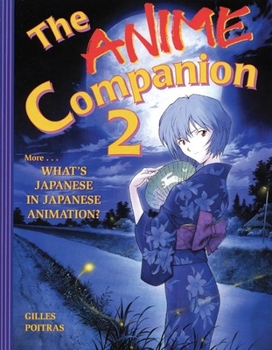The Anime Companion 2: More What's Japanese in Japanese Animation?
This long-awaited "companion" volume boasts over 500 all-new glossary-style entries to help you decipher anime's distinctive content, images and cultural motifs. Ranging from Aikido to Zero fighters... This description may be from another edition of this product.
Format:Paperback
Language:English
ISBN:1880656965
ISBN13:9781880656969
Release Date:June 2005
Publisher:Stone Bridge Press
Length:154 Pages
Weight:0.65 lbs.
Dimensions:0.4" x 7.0" x 9.0"
Customer Reviews
2 ratings
A good resource for understanding Japanese cultural references in anime
Published by Thriftbooks.com User , 15 years ago
The book is a companion to Poitras' 1999 book, The Anime Companion: What's Japanese in Japanese Animation? Like the first volume, this book is also an encyclopedia to Japanese references that appear in anime that non-Japanese viewers may understand or be familiar with. Sometimes, Poitras will include some asides in the text, such as fire as a weapon, explaining what a "Totoro" is, explaining the expressways of Japan, and other topics that don't fit into the main body of the book. There are also a number of illustrations and still pictures from anime programs to help illustrate some of the entries. One of the main issues I had with the first volume was how much Poitras seemed to rely on only a few anime titles to use as examples in the book. Poitras actually addresses this criticism in the introduction of the book. The explanation Poitras gives is that he hasn't necessarily gone out of his way to explore a particular show, but "it's just that some works have more material to work with." For some of the entries for The Anime Companion 2, I felt that Poitras missed some obvious examples for some of the entries. The most glaring one to me was the entry for the Yamato battleship. There is a still from Space Battleship Yamato included to illustrate the entry, but this anime is never mentioned in the actual write-up for the entry. There are references to Moldiver and Ranma 1/2 in the written portion of the entry, but it's not mentioned in the write-up that the battleship is a major component of the Space Battleship Yamato anime series. However, I have to say that the citations for the anime episodes are a lot clearer in this volume when compared to the citations for The Anime Companion. In the first book, Poitras was having to use videotapes for his citations; for some series, this created a nightmare for citations. With this volume, however, Poitras was able to use DVDs for his citations. The Anime Companion 2 also includes maps, an English-Japanese reverse lookup glossary, a listing of entries arranged by category, and selected references. Overall, this is a good book for anime fans, and it is an excellent companion for The Anime Companion. This book is a worthwhile addition to anyone's anime reference library, especially if they already have The Anime Companion: What's Japanese in Japanese Animation?
Highly recommended, especially for anime and Japanese popular culture fans
Published by Thriftbooks.com User , 18 years ago
Written by the author of "The Anime Companion", The Anime Companion 2: More... What's Japanese In Japanese Animation? is a reference especially for hardcore fans and casual viewers alike of Japanese animated movies and television shows, usually called "anime" for brevity. Both The Anime Companion and The Anime Companion 2 are arranged encyclopedia-style, but each one has its own list of A-Z entries; they are independent collections of entries gathered over the course of years. Like its predecessor, The Anime Companion 2 consists of entries, each one a few paragraphs in length, that define a specific Japanese geographical location, historical event or thing that often appears in anime and may well be unfamiliar to Western viewers. From the names of districts of Tokyo and other populous cities, to famous historical revolts, to foods commonly eaten in Japan, religious customs, and much more, the entries in The Anime Companion 2 give the casual browser a better understanding of Japanese daily life and culture roots. Entries are listed in alphabetical order according to the Romanized form of the Japanese words, but each one is also written in the traditional Japanese writing system of kanji, both the modern and old forms if applicable. All words that have an entry are in boldface for easy cross-reference, and icons show the reader at a glance the general facet of life that each word refers to: food, geography, religion, etc. The Anime Companion 2 especially focuses upon Japanese historical references, which were more scarce in anime when the first volume was published but seem increasingly common in modern anime, plus the author's sidebars and comments about anime fandom in general are intriguing. Highly recommended, especially for anime and Japanese popular culture fans.





